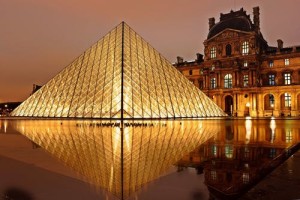The Masterful Modernism of I.M. Pei

I.M. Pei, who died last week in his Manhattan home at age 102, was among the most celebrated architects of the last century, widely praised for his high-profile designs of the East Building of the National Gallery of Art in Washington, D.C., and the glass pyramid entrance at the Louvre in Paris.
For me, a Denver native, his standout is a 22-story, block-long, four-building concrete International Style wonder situated in the city’s downtown. Though it is perhaps one of the lesser-known projects in the Pei oeuvre, the multi-purpose Mile High Center, completed in 1960, was ahead of its time, combining a hotel (opened as a Hilton and now a Sheraton), parking, public space, and a department store. This kind of development may be the norm now, but six decades ago it was revolutionary. Perhaps not surprisingly, the project was the winner of the American Institute of Architects’ National Honor Award in 1961. (Sadly, a pavilion on the site was later demolished, the department store was garishly updated, and the hotel now lacks many of its original interior details, which were gutted or destroyed though changes over time. Still, it is a beautiful building to behold.) Several years later, Pei would complete another exceptional structure nearby, the National Center for Atmospheric Research, subtly nestled into the rocky foothills of Boulder, Colo. His firm would also design Denver’s 16th Street Mall, which opened in 1982 and helped establish a new nexus for downtown.
Pei was both a visionary designer and a savvy businessman who had the shrewd ability to move within the wealthy and powerful with ease. And with the massive success of his architectural operation, I.M. Pei & Associates, which he set up in 1955—it later became I.M. Pei & Partners in 1966, and then Pei Cobb Freed & Partners in 1989—he too became wealthy and powerful. Writing this week in the New York Times, architecture critic Paul Goldberger noted that Pei “was one of the few architects who were equally attractive to real estate developers, corporate chieftains and art museum boards (the third group, of course, often made up of members of the first two).” This was Pei’s world.
In a way, he born into it—his father, Tsuyee Pei, was one of China’s leading bankers. His upper-class upbringing included moves from Guangzhou, where he was born, to Hong Kong and later Shanghai. His family’s culture was rooted in Chinese tradition but included access to Western ideas and ideals.
Much of Pei’s business acumen was shaped early on in his career, in the late 1940s. After receiving his master’s from the Graduate School of Design at Harvard, he taught for two years alongside Walter Gropius, founder of the Bauhaus School, whom he had also studied under. (Pei attended M.I.T. for his undergraduate studies and also did a stint at the University of Pennsylvania, which he transferred out of.) Eventually hired by the bold and brash New York developer William Zeckendorf, Pei began his architectural ascent in his early 30s, quickly entering a rarefied orbit of influence and money. Zeckendorf’s access to the wealthy and powerful provided a rare springboard for the young architect, who over the next few decades would go on to design lauded projects such as the Cleo Rogers Memorial Library in Columbus, Indiana (1963), Boston’s John F. Kennedy Presidential Library (1979), and the Bank of China Tower in Hong Kong (1990).
There aren’t many designers whose collective body of work could be called “timeless.” Or anyway, I certainly try to avoid that word when describing architecture. But with Pei, for the most part, it’s apt. His ingenious if straightforward uses of shapes and forms often led to grand, clean-lined buildings that showcased his strong and clear architectural voice. He was a true, pure, masterful modernist. You remember a Pei building when you visit one. The bulk of them have aged well, many of them for exactly that—their bulk. They evoke feeling and emotion. He was an architect who took the long view and as such made buildings that could stand the test of time.
Not everything Pei did was a smooth success, of course—Boston’s John Hancock Tower, with its construction snafus, financial troubles, and various delays, was a notable public failure, and New York’s Jacob K. Javits Convention Center has had more than its fair share issues and reasonable critiques, too. But there’s no doubt that Pei’s impact on the field of architecture, and on the world at large, has been—and will continue to be—long-lasting. His consistent, forward-thinking vision was his ultimate power.
Click here for article.